Making a list of birds with a long tail isn’t as straightforward as it seems. For example, the peacock is not on the list. Why? Because the beautiful feathers that trail behind it and that he fans out during courtship are not part of his tail. His real tail is rather stumpy and hidden beneath and behind coverts. Coverts are feathers that emerge from above or below the base of the tail.
Tail feathers grow from the bird’s tail or structures that are part of the tail. So finding birds who actually have long tails required some care. Plus, not only did the feathers have to originate from the tail, but they had to be nearly as long as the bird’s body.

It also helped if they were permanent and not part of the bird’s breeding plumage to be shed later, which ruled out the whydahs. The following are 10 birds who really do have long tails.
#10: White-tailed Tropicbird

©iStock.com/kellington1
This little seabird of the tropical oceans and the Caribbean not only sports a long tail but is one of the most beautiful of birds. It is mostly white but has black patches on its outer wings, diagonal black bands on its inner wings, and an orange beak.
It is the central feathers in the tail that are very long, which gives the bird an elegant silhouette as it flies. The tropicbird hovers over the water and snaps up squid, crabs, and flying fish.
In the U.S. this bird is mostly seen in Hawaii and around Dry Tortugas, and even Florida. It’s also considered the national bird of Bermuda where the longtail is actually given complete protection from hunters and other human predators.
#9: Superb Lyrebird

©iStock.com/neil bowman
The long tail of this Australian bird gives it its name. The tail is shaped like a lyre. This is one of the largest songbirds, and a male can be over three feet long and weigh a little over 2 pounds. The tail can be 28 inches long in the male.
It bears 16 feathers, with the outer two feathers in the shape of the frame of the musical instrument. In between are silvery filamentary feathers, and in the center of the “lyre” are two silver median feathers. The male performs a fantastic courtship ritual where he fans out his tail over his head and body and shivers the feathers while he sings and beats his wings.
#8: Common Pheasant
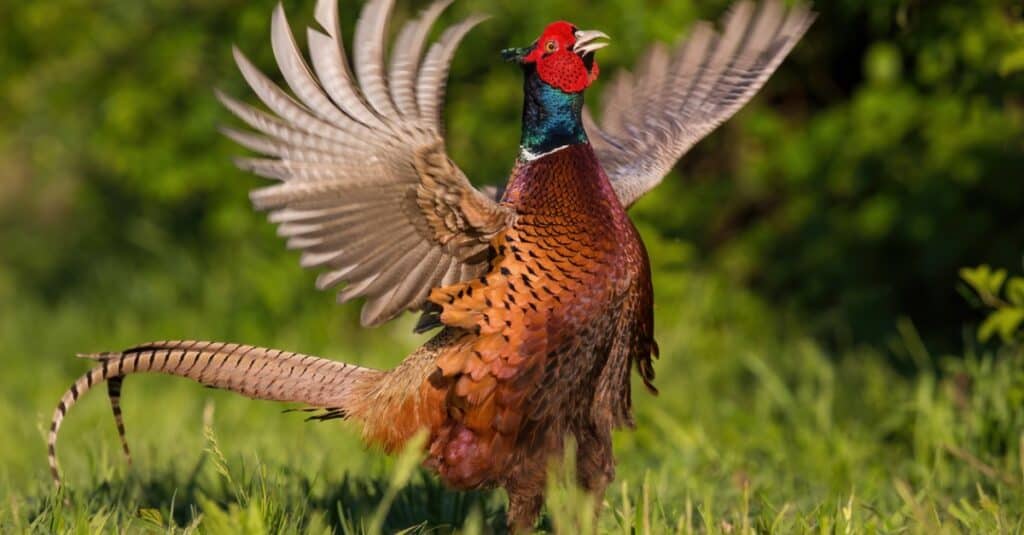
©iStock.com/JMrocek
This bird originated in Asia and the Balkans but can now be found in the northern part of the United States, the southern part of Canada, and much of Europe. Indeed, it’s the state bird of South Dakota. Thanks to different subspecies interbreeding and being bred in captivity, the common pheasant can come in a variety of colors and patterns.
But a “standard” male pheasant has a coppery plumage with purple or green iridescence, black or white bars on the wings, and a dark green head with a fire engine red wattle. It can be 24 to 35 inches long, with 20 inches of that being made up of the tail, which is brown and streaked with black. The hens are much drabber, but they too have long tails in proportion to their bodies.
Learn more about pheasants here.
#7: Great Argus Pheasant

©Danny Ye/Shutterstock.com
This pheasant native to southeast Asia is even bigger than the common pheasant, and though it belongs to the same family is in a different genus. The male can be 79 inches long and weigh 6 pounds, and much of that length is made up of its tail. However, the Argus’ long tail isn’t what’s spectacular about it. That would be its huge, secondary wing feathers, which along with the tail are used to woo females. The wings are full of tiny eyes that gave the bird its name, for Argus was a giant in Greek mythology who had 100 ceaselessly watching eyes.
During its courtship ritual, the male clears a space in the forest, calls to bring the females. When they gather to watch, he opens his wings in two huge fans, throws up his long tail feathers behind them, and dances. Unfortunately, this remarkable bird is listed as vulnerable due to habitat loss and hunting.
#6: Alexandra’s Parrot

©Janet Faye Hastings/Shutterstock.com
Lots of parrots and parakeets have long tails, but the tail of Alexandra’s parrot, or the Princess parrot, is longer still. Native to Australia, it’s also a pretty bird with plumage of pink, blue, and green. As with so many other birds, the male’s tail is longer than the female’s and she’s duller overall. He also has a beak whose color is described as coral red and orange eyes.
Because it is kept as a pet and bred in captivity, there are at least three color variations of this bird. Alexandra’s parrot can live for 30 years, and some can be taught to talk. Its conservation status is near threatened in its native habitat.
Go here to learn more about parrots.
#5: White-bellied Go-Away Bird
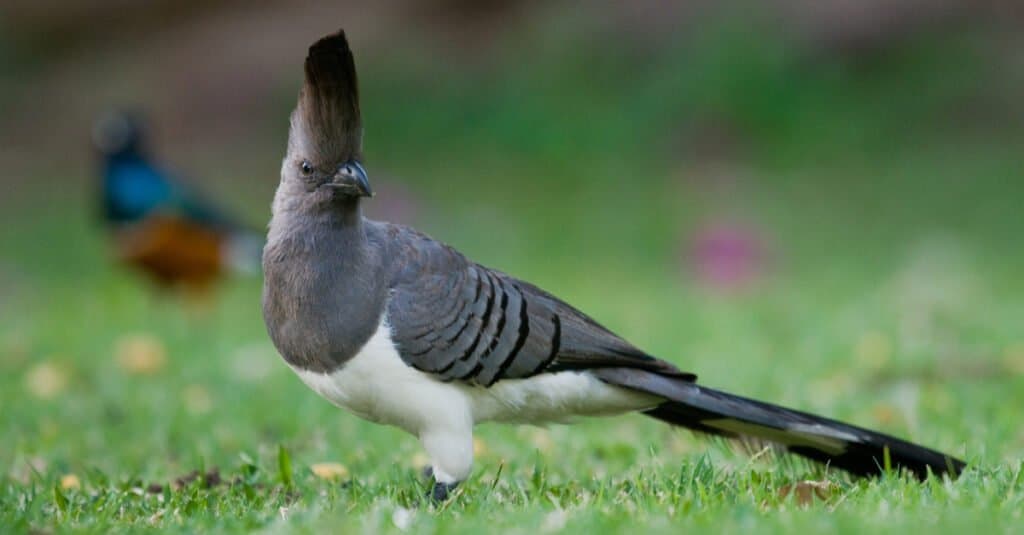
©Bartosz Budrewicz/Shutterstock.com
Found in East Africa, this turaco gets its name from its call, which sounds like “G’wa!” It’s a large perching bird, about 20 inches long, and a member of the Crinifer genus. Its species can be told by the long tail, which is black or gray and has a white band across the middle of the feathers. The bird gets the other part of its name from the color of its belly and the coverts found under its tail. Despite its name, the go-away bird is gregarious and likes to live in groups of as many as 10 birds.
#4: Streamertail
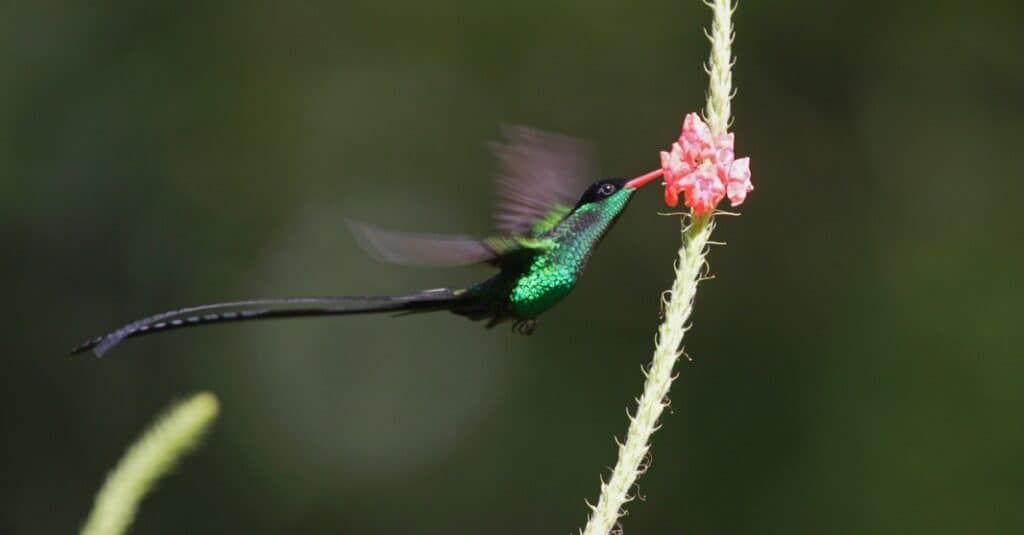
©iStock.com/neil bowman
A good number of hummingbirds have long tails, but streamertail hummingbirds stand out. The males of these little birds have exceptionally long rectrices. These are feathers that emerge from the rear edge of the tail, with the central feathers attached to the actual tailbone. The other feathers are attached to structures made of muscle and fat that surround the tailbone. They always come in pairs, and so there’s always an even number of them. The longest rectrices of streamertails are much longer than their bodies, and females don’t have them.
There are two species of streamertails; the red-billed and the black-billed. Both are found in Jamaica and the red-billed is the country’s national bird. Some biologists believe the black-billed is a subspecies of the other bird.
Read here to learn more about hummingbirds.
#3: Greater Racket-tailed Drongo
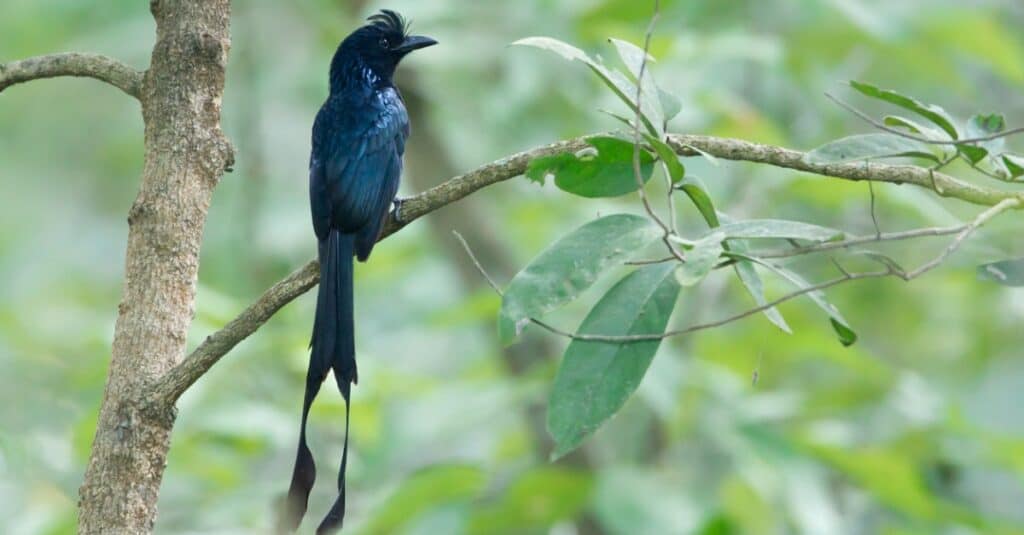
©iStock.com/Utopia_88
This striking bird of Asia is famous for two elongated outer feathers that sprout from a forked tail. They are made of “wires” that end in twisted, twirling rackets. When the bird flies, the rackets flutter very much like flags in the wind. Even without the long tail, the drongo would be one of the largest of its genus, with a body that can be 25 inches long. Besides those very striking rackets, the bird also has a collapsible crest whose size varies depending on where the bird lives. It’s found in the bamboo and rainforests of south China and as far away as Bali and Java.
#2: Fork-tailed Flycatcher
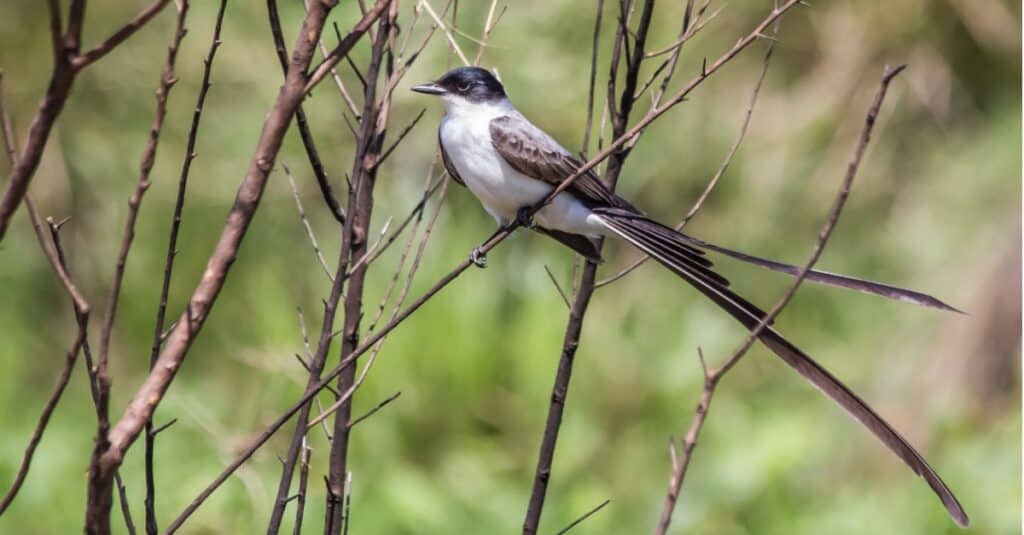
©iStock.com/venemama
Found mostly in Mexico and south through Argentina, this bird is known for its exceptionally long tail, which is forked and as much as three times as long as the bird’s body. It has a white belly, a black cap, and is gray on top. Sometimes the crowns of the males have a yellow patch that is hidden beneath the black. Even the female has a long tail in this species, but the tail of the male is longer.
The flycatcher hunts by sallying, so it is often seen perching on a tree limb or even on barbed wire. When it sees an insect on the wing, it flies out, grabs it, eats it, then comes back to its perch. Sometimes fork-tailed flycatchers gather in huge flocks to hunt.
#1: White-throated Magpie-jay

©Azahara Perez/Shutterstock.com
This eye-catching bird is found in northwestern Mexico. It’s not only blessed with an exceptionally long tail but a forward-leaning crest and vividly colored plumage. All in all, the magpie-jay can be 30 inches long, and more than half of it is its tail. It is a lustrous steel blue on top, with a white belly, and a midnight blue or black crest and bib and cheek patches. The bill and legs are the same color, and the tips of the tail feathers are white. As a corvid, it’s an omnivore it eats anything it can handle, including berries and insects. The black-throated magpie-jay sometimes breeds with the white-throated magpie jay, whose tail is also long, but not that long.
Summary of 10 Birds with Long Tails
| Rank | Birds |
|---|---|
| 10 | White-tailed Tropicbird |
| 9 | Superb Lyrebird |
| 8 | Common Pheasant |
| 7 | Great Argus Pheasant |
| 6 | Alexandra’s Parrot |
| 5 | White-bellied Go-Away Bird |
| 4 | Streamertail |
| 3 | Greater Racket-tailed Drongo |
| 2 | Fork-tailed Flycatcher |
| 1 | White-throated Magpie-jay |
Are There Other Long-tailed Birds?
Since there are over 10,000 species of birds (maybe twice that), it’s a good bet that there are other long-tailed types. Here are a couple more that we have identified, but you might also be interested in the Long-tailed Tit, the Red-bellied Streamertail, or the Aegithalos:
Scissor-tailed flycatcher: a small North American bird with a gray head, dark wings, a pinkish-orange wash on the sides, and a black beak. Found mostly in Texas, this bird migrates to Central America in the winter. Like the fork-tailed flycatcher, it has a long tail with a gap in the middle, thus looking like scissors. The unique tail helps with balance and allows the bird to twist and turn sharply and quickly when pursuing grasshoppers, beetles, crickets, and other insects while in flight.
Greater Roadrunner: Made famous in the Wile E. Coyote cartoons, the roadrunner has a notable tail held at an upward angle and steering like a rudder when the bird runs. This ground-dwelling bird lives in the southwestern United States and Mexico, in the deserts and scrublands where it can run up to 17 mph as it chases down insects, frogs, other birds, and small mammals for meals.
.
The photo featured at the top of this post is © iStock.com/Utopia_88
Thank you for reading! Have some feedback for us? Contact the AZ Animals editorial team.






